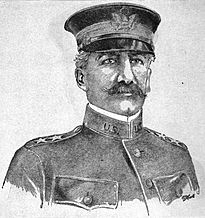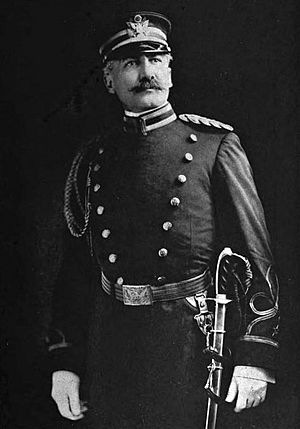George Windle Read facts for kids
Quick facts for kids
George Windle Read
|
|
|---|---|
 |
|
| Born | November 19, 1860 Indianola, Iowa, United States |
| Died | November 6, 1934 (aged 73) Washington, D.C., United States |
| Buried |
Arlington National Cemetery, Arlington, Virginia, United States
|
| Allegiance | |
| Service/ |
|
| Years of service | 1883–1925 |
| Rank | |
| Unit | |
| Commands held | 152nd Depot Brigade 77th Infantry Division 15th Cavalry Division 30th Infantry Division II Corps American Embarkation Center, Le Havre, France 42nd Infantry Division V Corps Philippine Department |
| Battles/wars | Spanish–American War Pancho Villa Expedition World War I |
| Awards | Army Distinguished Service Medal |
Major General George Windle Read (born November 19, 1860 – died November 6, 1934) was an important United States Army officer. He was well-known for leading large groups of soldiers, called corps and divisions, during World War I. After the war, Read also managed the return of American soldiers from Europe as the commander of the American Embarkation Center in Le Havre, France.
Contents
Early Life and Military Start
Read was born in Indianola, Iowa. He studied at the United States Military Academy (often called West Point) and graduated in 1883. After graduating, he became a Second Lieutenant in the Infantry, which is the part of the army that fights on foot.
His first jobs were in the western United States. He served with the 16th Infantry Regiment and then the 5th Cavalry Regiment. Cavalry units are soldiers who fight on horseback.
From 1889 to 1893, Read taught military science at the University of Iowa. After that, he went back to the 5th Cavalry Regiment in Texas. In 1898, he even wrote a book called The Automatic Instructor.
Serving in Wars and Abroad
When the Spanish–American War began, Read joined an Ordnance unit. This unit deals with weapons and ammunition. He served in Cuba until 1899. He was promoted to Captain and then served in New Mexico before being sent to the Philippines.
After the Spanish-American War, Read continued his service in California and Hawaii. From 1905 to 1909, he worked on the Army's General Staff, which helps plan and organize the army. He became a Major and served in Cuba, Puerto Rico, and the Philippines. He then attended the Army War College, a school for high-ranking officers, graduating in 1914.
After graduating, he became a Lieutenant Colonel. He served in Texas and Arizona during conflicts along the US–Mexico border, including the Pancho Villa Expedition. From 1915 to 1917, he was back in Washington, DC on the Army General Staff.
World War I Leadership
In April 1917, as the United States prepared for World War I, Read, now a Colonel, was put in charge of finding new soldiers. In August, he was chosen to command the 152nd Depot Brigade in New York. This unit helped train new recruits.
In December, Read was promoted to temporary Major General. He commanded the 77th Infantry Division and then the 15th Cavalry Division in El Paso, Texas.
The 15th Cavalry Division was later changed into an Infantry division. In April 1918, Read took command of the 30th Infantry Division and led them to France. In June, he was chosen to command the II Corps. A corps is a very large military unit, often made up of several divisions. His II Corps had five divisions and was assigned to the British part of the Western Front.
Later, three of his divisions were moved to fight in the Saint-Mihiel Offensive. Read continued to command the remaining two divisions. These divisions joined the Australian Corps in the Ypres area. They played a part in the Hundred Days Offensive (August–November 1918), which helped break through the strong German defenses known as the Hindenburg Line.
Read continued to lead the II Corps even after the war ended with the Armistice in November 1918. After his corps was disbanded in February 1919, Read was put in charge of the American Embarkation Center in Le Havre, France. His job was to organize the transportation of American soldiers and equipment back to the United States. He also commanded the 42nd Infantry Division as they finished their duties in Germany and prepared to leave Europe.
After World War I and Retirement
In May 1919, Read was assigned to command the US V Corps in South Carolina. He was given the permanent rank of Brigadier General. In March 1921, he received a permanent promotion to Major General.
In October 1922, Read became the commander of the Philippine Department, a military command in the Philippines. He took command in early 1923 and stayed in this role until he retired in 1925.
Awards and Family
General Read received several important awards for his service. These included the American Distinguished Service Medal and the British Order of the Bath. He also received French awards: the Legion of Honor (Commander) and the French Croix de Guerre with Palm.
After retiring, Read lived in Upper Providence Township, Pennsylvania. He passed away at Walter Reed Army Hospital on November 6, 1934. He was buried at Arlington National Cemetery.
In 1886, Read married Burton Young. Her father, General S.B.M Young, was the first Army Chief of Staff. George and Burton Read had children who also served in the military. Their son, Burton Young Read, was a career soldier who retired as a Colonel after serving through World War II. Another son, George Windle Read Jr., also had a long military career, serving in both world wars and becoming a Lieutenant General. He commanded the US Army Armor Center and the Second United States Army.


